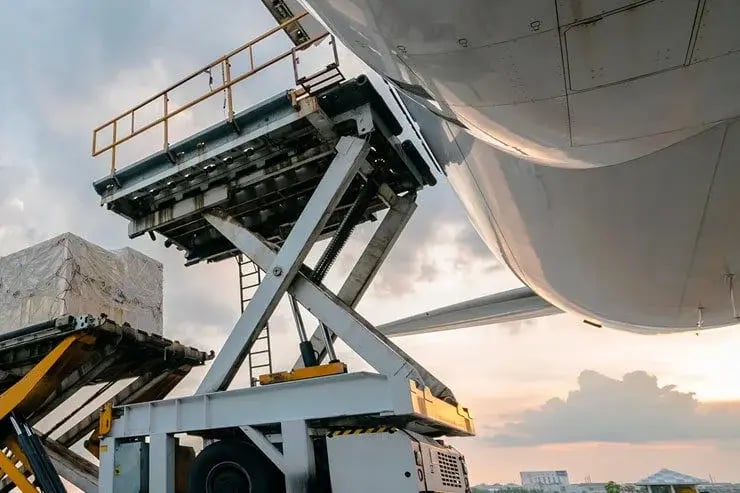May 2, 2025 | BY Dan Boaz
Air Charter Broker
Global supply chains have never moved faster—or been under greater pressure to stay agile. E-commerce sales topped US $6 trillion in 2024, and with that growth came unprecedented demand for capacity on every cargo plane, freight plane, and belly-hold worldwide.
Share this article
The International Air Transport Association (IATA) reports that cargo tonne-kilometers (CTKs) expanded 8.2 % year-on-year in November 2024, the sixteenth straight month of growth—evidence that air freight shipping retains its crown as the go-to mode when time truly is money.
Yet the market’s very success produces bottlenecks: booked-out freighter aircraft, congested hubs, and a shrinking margin for error when customers expect same day delivery. Enter the air charter broker...by pairing deep aviation expertise with a network of certified operators, brokers can unlock aircraft charter capacity—often in hours—and dovetail it neatly into a shipper’s existing distribution model. For logistics professionals juggling volatile demand, an air charter broker is less a “middleman” than an on-call strategic partner.
AIR CHARTER SERVICES
Air charter is the supply chain’s emergency lane, providing on-demand lift when scheduled services can’t meet the clock. Because a dedicated aircraft departs at the shipper’s chosen time, cargo can move from factory floor to destination in hours instead of days, bypassing the fixed timetables, multi-stop routings, and capacity limits of scheduled freighters or bellies.
This agility is indispensable for industries where production lines halt without a single missing component—automotive, high-tech, oil & gas, and pharma rely on charters to keep just-in-time operations intact. In crises, from natural disasters to medical emergencies, charter flights are often the only way to deliver relief supplies or critical equipment when every minute counts.
TALK TO AN EXPEDITOR NOW
Get a Quote in Minutes for Your Time-Critical Freight Needs
Information Needed for an Air Charter Quote
Cargo Details:
- Type of cargo (e.g., general goods, hazardous materials)
- Weight and dimensions (length, width, height)
- Any special handling requirements (e.g., temperature control, pressure sensitivity)
Shipping Details:
- Origin
- Destination
- Desired transit time
Other Factors:
- Origin
- Closest airports for cargo pickup and delivery
- Any add-on services needed (e.g., customs clearance, ground handling)
Factors Affecting Air Charter Costs:
- Aircraft Type and Size
- Aircraft Positioning
- Freight Route
- Weight and Volume of Cargo
- Fuel Costs
- Season and Market Demand
- Weather Conditions
- Time of Day
- Airport Size
- Airport Loading/Offloading Capabilities
- Specialized Handling Requirements
- Additional Services
The Role of Air Charter Brokers in Logistics
The sheer complexity of global trade today makes it unrealistic for shippers or 3PLs to master every aviation variable. The air charter broker fills that gap, integrating seamlessly with procurement, inventory, and distribution workflows. Their value is amplified by current market dynamics: 2024’s average cargo load factor hit 45.9 %, up 1.6 points year-on-year—a tight environment where ad-hoc capacity is increasingly scarce.
At the same time, the broker industry itself is expanding; analysts project the air charter broker market will grow to US $2.5 billion by 2033 at a 3.5 % CAGR.

Multimodal Integration & Specialized Aircraft
Many logistics networks run on a hub-and-spoke model: trans-pacific freighter flights feed gateway warehouses, and from there LTL or courier vans handle final distribution. Brokers enable a “spoke-to-spoke” shortcut, inserting an aircraft cargo leg exactly where time or dimensional constraints warrant—say, lifting a 5,000-kg MRI magnet from a German plant directly to an Idaho hospital heliport via Antonov An-26.
Because brokers understand both aviation and ground realities, they coordinate cranes, scissor-lifts, and DG escorts at each end, bundling costs into one all-in rate. The result: multimodal harmony with no blind spots between modes, reducing dwell and demurrage charges.
Peak-Demand Capacity Smoothing
E-commerce flash sales, holiday launches, or automotive recalls can spike air freight demand overnight. Scheduled carriers may impose weight restrictions or roll cargo. Brokers pre-source uplift on dedicated freighter aircraft, convert passenger jets to “preighters,” or orchestrate multi-stop milk-runs that consolidate split cargo at hub airports. By paying only for the capacity you need, when you need it, shippers avoid long-term ACMI leases yet still guarantee lift during seasonal surges.
Two additional benefits follow: first, more predictable landed costs because emergency premiums are baked into negotiated contracts; second, the ability to protect service-level agreements with end customers, shielding reputational risk.

Risk Management & Regulatory Navigation
Aviation regulation is intricate and varies by jurisdiction. An incorrectly filed E-APIS manifest or a missing overflight permit can cancel a mission. Brokers maintain compliance databases, monitor sanction lists, and engage directly with civil aviation authorities. They also vet operators for IOSA or Wyvern Wingman credentials, ensuring your cargo flies aboard aircraft that meet the safety standards your insurers require.
On the risk-transfer side, brokers secure contingent cargo insurance and recommend packaging upgrades when vibration or temperature excursions threaten sensitive goods. That proactive counsel converts unknowns into mitigated, budgeted line items—critical for CFOs demanding supply-chain resilience.

Air Charter Advantages
- Speed That Beats the Clock
- Flexible Routing & Remote Reach
- Capacity Control for Oversized & Dangerous Goods
- Security & Reduced Handling Risk
- End-to-End Visibility & Compliance
- Rapid Disruption Recovery
Speed That Beats the Clock
Aircraft charter is the undisputed champion of transit time, flying direct from origin to destination with no intermediate stops, transfers, or cross-docks. When a North American automotive line faces a two-hour shutdown window, a Gulfstream G550 configured for air shipment cargo can depart from Mexico and land in Detroit the same afternoon—saving six-figure downtime penalties compared with deferred air freight.
Flexible Routing & Remote Reach
Scheduled carriers serve major gateways; charter service reaches the rest. A broker can position a STOL-capable freighter to an unpaved strip in the Yukon or schedule a midnight slot into Leipzig when line-haul flights are full. That flexibility keeps mining spares, humanitarian relief, or oil-and-gas equipment flowing without costly road feeder legs.

Capacity Control for Oversized & Dangerous Goods
Need to move 20-ton generators, live animals, or UN 3480 lithium batteries? With charter you choose the aircraft, interior configuration, and load plan—eliminating unit load device constraints and airline embargoes. Nose-loaders like the Boeing 747-8F or swing-tail L-100-30 handle freight other modes simply cannot.Security & Reduced Handling Risk
Direct uplift means cargo is touched once at origin and once at destination, slashing theft exposure and damage. Sensitive pharma or high-value electronics stay under continuous chain-of-custody, overseen by a dedicated broker operations team and real-time GPS flight watch.End-to-End Visibility & Compliance
Modern brokers integrate XML flight status feeds straight into a shipper’s TMS, giving stakeholders minute-by-minute updates. They also shepherd documents—shippers’ declaration, NOTOCs, DG exemptions—ensuring every air charter shipping movement meets IATA DGR and local customs rules.
Rapid Disruption Recovery
Volcanic ash grounding European hubs? Port strikes spiking ocean dwell times? Charter brokers maintain standby aircraft and pre-negotiated slots so supply chains can pivot within hours. This agility explains why aerospace OEMs and semiconductor fabs routinely build “air charter trigger points” into business-continuity plans.
Why Choose SameDayAir.com?
For organizations that live and die by the clock, SameDayAir.com is the air charter company that keeps production lines humming. Drawing on a global roster of cargo transport planes—from nimble turboprops to nose-loading freighter aircraft—our logistics specialists orchestrate every movement with minute-by-minute precision. The result? Air charter freight that arrives exactly when you promised, even under extreme deadline pressure.


